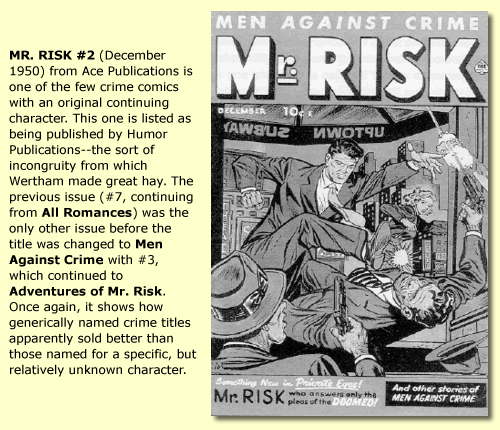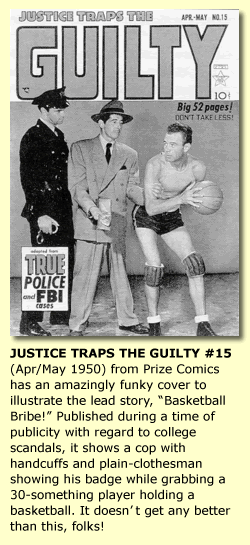page 3 of 3
Ken Shannon not only featured outstanding art from the Quality stable, but darned good stories straight out of the pulps and lurid paperbacks of the period.
Other than T-Man and Ken Shannon, how many original detective characters had their own comic books, however brief? The answer will surprise you: a very short list indeed.
|
HARD
TO FIND CRIME!
40 tough books 1942-56 |
|
|
KEY:
Title Issue# (Date, Publisher) Gerber Scarcity Index |
|
| Big Town #3 (Mar 1951, DC) 4 | |
| Charlie Chan #6 (Jun 1955, Charlton) 8 | |
| Clue Comics #3 (May 1947, Hillman) 4 | |
| Crime Clinic #5 (Summer 1952, Ziff Davis) 5 | |
| Crime Detective Cases #9 (Aug 1949, Hillman) 6 | |
| Crime Does Not Pay #22 (#1, Jul 1942, Gleason), 7 | |
| Crime Does Not Pay #23 (Sep 1942, Gleason), 6 | |
| Crime Does Not Pay #24 (Nov 1942, Gleason), 7 | |
|
Crime Files #5 (#1, Sep 1952, Standard) 5 |
|
| Crime Illustrated #1 (Dec 1955, EC) 6 | |
| Crime Illustrated #2 (Apr 1956, EC) 6 | |
| Crime Must Stop (One-shot, Oct 1952, Hillman) 7 | |
| Crime Reporter #3 (Dec 948, St. John) 5 | |
| Crime Mysteries #5 (Jan 1953, Trojan) 6 | |
| Crime Smasher (One-shot, Summer 1948, Fawcett) 5 | |
| Danger Trail #3 (Dec 1950, DC) 7 | |
|
Danger Trail #5 (Apr 1951, DC) 6 |
|
| Dead-End Crime Stories (One-shot, Apr 1950, Kirby) 7 | |
| Down With Crime #5 (Jul 1952, Fawcett) 6 | |
|
Gang World #6 (Jan 1953, Standard) 6 |
|
| Hunted #2 (Sep 1950, Fox) 4 | |
| The Informer #7 (Apr 1954, Feature) 6 | |
| Ken Shannon #5 (Jun 1952, Quality) 4 | |
| The Killers #7 (no month, 1947, ME) 5 | |
| The Killers #2 (no month, 1948, ME) 7 | |
| Law Against Crime #3 (Aug 1948, Essankay) 5 | |
| Manhunt #9 (Jun 1948, ME) 5 | |
| Mr. Risk #7 (#1, Oct 1950, Ace) 5 | |
| Mr. Risk #2 (Dec 1950, ME) 6 | |
| Police Badge #479 (#5, Sep 1955, Atlas) 4 | |
| Police Comics #109 (Nov 1951, Quality) 5 | |
| Prison Riot (One-shot, no month, 1952, Avon) 5 | |
| Racket Squad in Action #1 (Mar 1954, Charlton) 5 | |
| Reform School Girl (One-shot, no month, 1951, Avon) 7 | |
| Saint #8 (no month, 1950, Avon) 6 | |
| Sherlock Holmes #1 (Oct 1955, Charlton) 6 | |
| Sherlock Holmes #2 (Mar 1956, Charlton) 6 | |
| True Crime Comics #2 (#1, May 1947, Magazine Village) 6 | |
|
True Crime Comics #3 (#2, Aug 1947, Magazine Village) 6 |
|
| Underworld Crime #7 (Jun 1953, Fawcett) 6 | |
| Who is next? #5 (#1, One-shot, Jan 1953, Standard) 6 |
Such characters were Boy Detective (Avon), Crime Smasher (Fawcett), I’m a Cop (Magazine Enterprises), Jeff Jordan (Parents), Johnny Danger (Toby), Johnny Dynamite (Comic Media and Charlton), Kent Blake (Marvel), Little Al (Ziff-Davis), Molly O’Day (Avon), Mr. Risk (Ace), Private Eye-Rockey Jorden (Marvel), Public Defender (Charlton), Rookie Cop (Charlton), Rusty, Boy Detective (Gleason), Sam Hill (Archie), Scotland Yard starring Inspector Farnsworth (Charlton), Breeze Lawson, Sky Sherriff (D.S. Publishing), Special Agent Steve Saunders (Parents), Undercover Girl Starr Flagg (ME), Young King Cole (Curtis) and Zaza the Mystic (Charlton).
How many of these characters are you familiar with? I’d be willing to bet that not one collector in a hundred has read any of these comics.
Benton points out on page 45 of Crime Comics that one book title in seven from 1948-49 period was a crime title. That seems about right, but their influence was generally brief, and, as Gerber’s graph shows, crime comics were certainly never more than one-seventh of the market.
Crime-fighting characters, be they cops or G-Men, simply did not prove to be nearly as commercially successful as superheroes had been or would be again.
The creation of the Comics Code late in 1954 (the first Code Approved Comics were dated March and April 1955) did not specifically forbid the use of the word “crime” in the title. Even so, by the end of 1955, not a single comic book on the market used “crime” in the title.
I suspect that, even with the Comics Code symbol, that many newsstands simply wouldn’t take comics with “crime” in the title, so adverse had the publicity against them been.
Collecting post-Code crime comics is fun, largely because they are as scarce as they are tame. I suspect they did not sell very well, and most probably ran into distribution problems.
The last issue of Gleason’s Crime and Punishment (#74, August 1955), looks more like a romance comic, with a man attending to an unconscious woman while another woman urges him to help her.
Such a cover would never have been published in the pre-Code days. One of the most enjoyable aspects of collecting post-Code comics of all types in the 1955-56 period is seeing how the artists and editors tried to cope with the Comics Code.
I (like many) collect crime comics mostly for their “funkability” factor, either with regard to the stories or the covers. Fortunately, most crime comics remain in the affordable range, especially in mid and lower grades.

On a final note, the reporter-as-crook catcher genre is one of my favorites, although you don’t find it too often in comic books. You do, however, find it in many old paperback books and pulp magazines of the 1930s, ’40s and ’50s. For example, Coxe created both Flashgun Casey and reporter Kent Murdock, both excellent examples of the genre and the subject of several excellent novels reprinted in Dell paperbacks.
 Big
Town, detailing the exploits of Illustrated Press editor Steve Wilson,
is one of my favorite DC titles. It’s also one of the most difficult to
complete (how many collectors besides this writer and Ye Editor have a
complete set of all 50?). These are terrifically plotted stories--proof
positive that a crackling good tale can be told in 8 or 10 pages!
Big
Town, detailing the exploits of Illustrated Press editor Steve Wilson,
is one of my favorite DC titles. It’s also one of the most difficult to
complete (how many collectors besides this writer and Ye Editor have a
complete set of all 50?). These are terrifically plotted stories--proof
positive that a crackling good tale can be told in 8 or 10 pages!
When I got into the newspaper field in the mid-1960s, it was still a pretty romantic business, run by crusty old editors in noisy, crowded offices filled with smoke. Even though the Superman television series of the 1950s inspired me to take an insterest in newspapers, I must admit very few reporters had private offices such as Clark Kent and Lois Lane enjoyed.
These days, however, working in a newspaper office is akin to laboring in a library, complete with carpets and computers. Reporters set their own type while working on computers, editors are often horribly overworked while doubling as backshop production people, and newspapers in general employ only a fraction of the people they once had on their payrolls. Watching one of those wonderful old newspaper films such as Deadline USA (1952, starring Humphrey Bogart) is enough to make an old-style reporter cry!
I’d be interested in your reactions to the topic of crime comics. In the meantime, remember the motto of Hillman’s Real Clue Crime Comics “Commit a Crime and the World is Made of Glass!”
As for history’s case against most pre-Code crime comics, I say the verdict for most of them is...NOT GUILTY!
Michelle Nolan is a nationally recognized collector and researcher of comic books from the ’40s through the ’60s.
Originally
published in
Comic Book Marketplace #65
(December, 1998)
©1998
S.A. Geppi, all rights reserved.
Used with permission.
Special thanks to Gary Carter and Jeff Vaughn of Gemstone
Publishing for allowing me to include this article.

